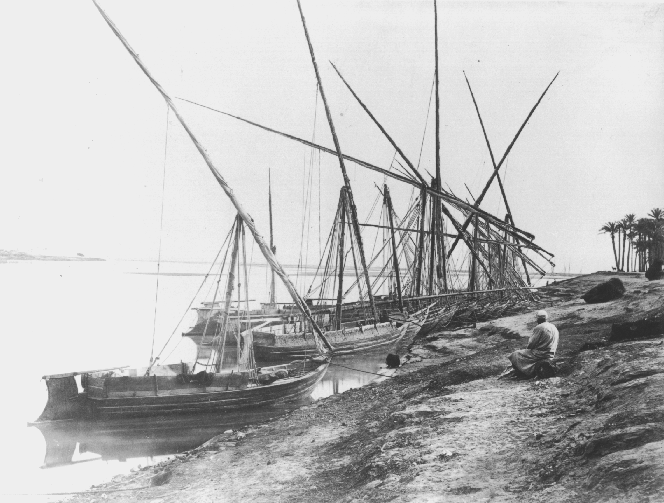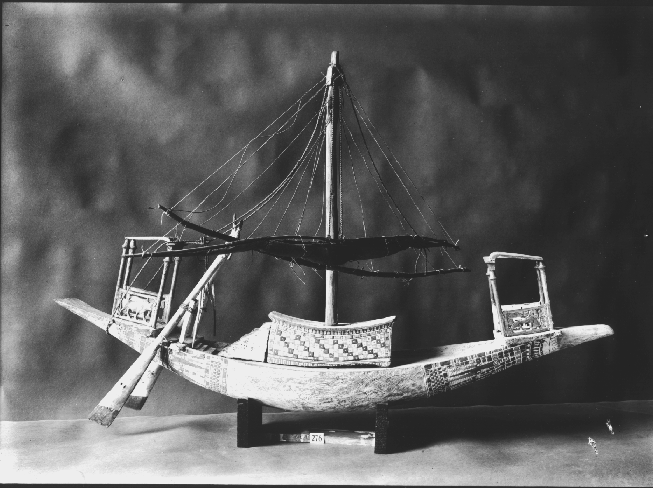
Feluccas at Kom Ombo. Photograph taken by un unknown photographer before 1872. Griffith Institute photo. 3498. Copyright Griffith Institute, Ashmolean Museum, Oxford.
From your question it would appear that you may, perhaps, be unaware that ancient Egyptian boats differed considerably from more "modern" craft such as the felucca. The felucca is a small sailing or rowing vessel, broad in the beam and of shallow draft, with one or two masts, and is a comparatively recent introduction into Egypt. It differs from ancient Egyptian boats in that: it is (1) skeleton-built (i.e. has a keel and ribs), (2) has a lateen sail (a narrow, triangular fore-and-aft sail set on a very long yard usually longer than the boat itself) with its forward end bowsed well down so that it sits obliquely on the mast and produces a high peak), and (3) has a central rudder aft.
The ancient Egyptians of Tutankhamun 's time (1336-1327 BC) set about building their boats in quite a different way to modern practice. The shipwright began his hull with a sort of "keel-plank" made of several lengths of wood fastened together which formed the centre-line of the whole construction (not a true keel which consists of one longitudinal timber running the length of the vessel). Short, thick planks were then added in brick-like fashion on either side, fastened edge-to-edge by means of mortise-and-tenon or dovetail cramps or a combination of both (not fastened to a pre-erected framework of ribs which rose from the keel). When the shell of planks had reached the required height, the whole construction was finished off with gunwales and a series of cross-beams were inlet into the uppermost strake on either side (i.e. shell-built). These beams supported the weight of the deck planking, and also served to provide lateral support to the hull. The hulls of larger vessels were often strengthened by the addition of a carling or stringer supported on vertical stanchions inset into frames at the bottom of the hull which extended the whole length of the vessel from stem to stern just under the cross-beams. Sometimes the shell was further braced by the insertion of several "passive" strengthening frames.The planks were set carvel fashion, that is, edge-to-edge, and never overlapped, as in clinker- built ships (e.g. Viking long ships).
Unlike the felucca, ancient Egyptian boats were propelled by a low, broad sail suspended from a pole mast stepped amidships. The sail was bent to two yards which were made from two pieces of wood fished together at their mid- point. The lower yard or boom was fixed to the mast with a parrel-lashing which allowed it to rotate freely about its axis. The upper yard was moveable, and could be raised and lowered with halyards (the main ropes used to hoist/furl the sail) which were attached directly to the upper yard on either side of its mid-point and made fast to the quarters. Lifts supported the weight of the yards and braces and sheets were used to control the angle of the upper yard and the boom.
Unlike the felucca which has a rudder hung from a sternpost or transom allowing lateral movement from side to side controlled by a long tiller lashed to the side or upper end of the rudder stock, ancient Egyptian vessels were steered by two large oars mounted on each quarter (the rudder only began to replace steering oars/paddles in the mid-13 century). Their upper ends were mounted on forked stanchions lashed to the posts by plain bindings and by tackles of rope under tension while their looms rested in grooves cut into the outer ends of a protruding cross-beam just abaft the posts. They were manipulated by long, vertical tillers dowelled into their looms.

Feluccas at Kom Ombo. Photograph taken by un unknown
photographer before 1872. Griffith Institute photo. 3498.
Copyright Griffith Institute, Ashmolean Museum, Oxford.

Model boat from the tomb of Tutankhamun, now in Cairo
Museum, JE 61329. H. Burton photo. 1076. Copyright Griffith
Institute, Ashmolean Museum, Oxford.
(November 4, 1996)
(D. Jones)